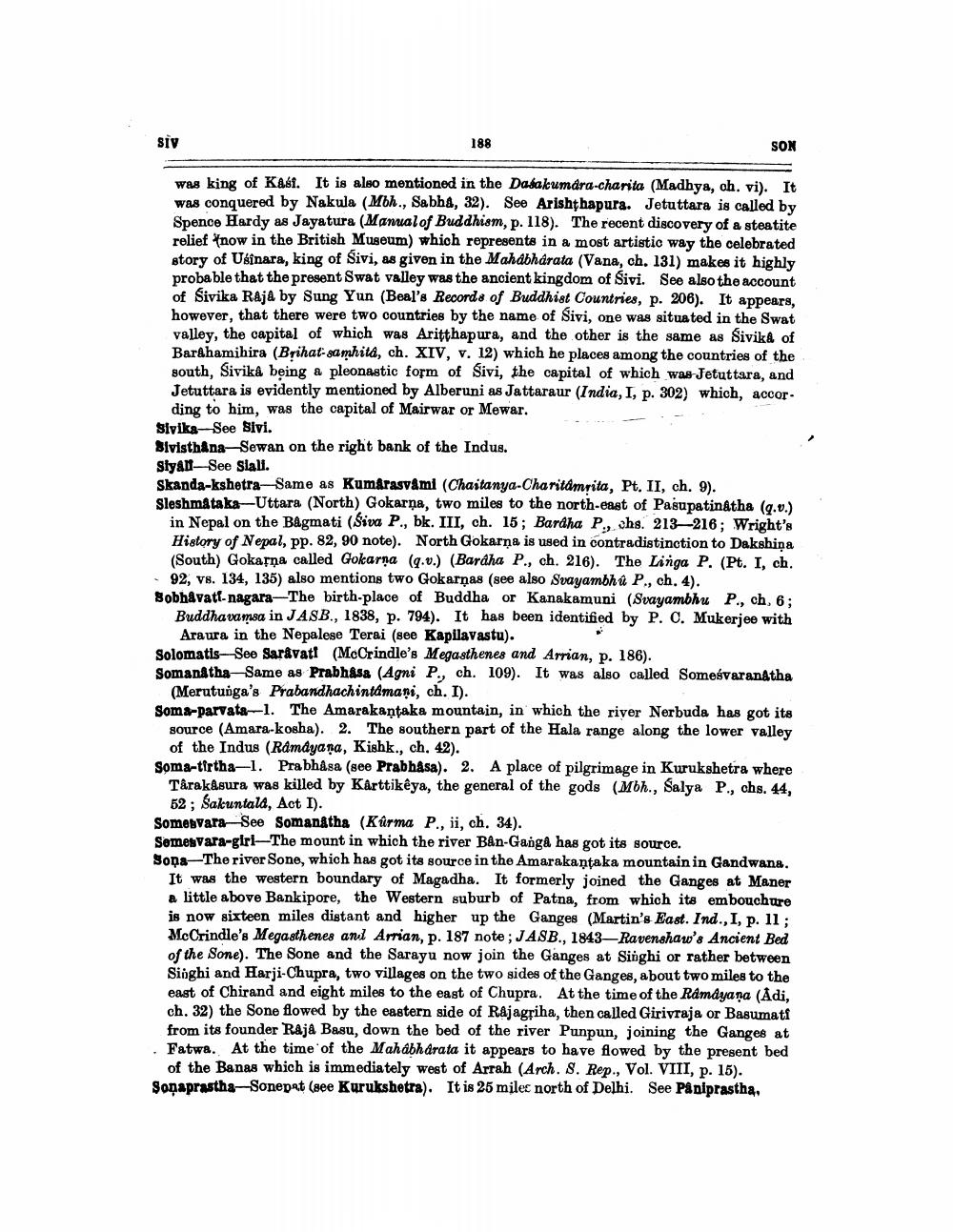________________
SIV
188
SON
was king of Kaéf. It is also mentioned in the Dasakumdra-charita (Madhya, oh. vi). It was conquered by Nakula (Mbh., Sabha, 32). See Arishthapura. Jetuttara is called by Spence Hardy as Jayatura (Manual of Buddhism, p. 118). The recent discovery of a steatite relief (now in the British Museum) which represents in a most artistic way the celebrated story of Usinara, king of Sivi, as given in the Mahabharata (Vana, ch. 131) makes it highly probable that the present Swat valley was the ancient kingdom of Sivi. See also the account of Sivika Raja by Sung Yun (Beal's Records of Buddhist Countries, p. 206). It appears, however, that there were two countries by the name of Sivi, one was situated in the Swat valley, the capital of which was Aritthapura, and the other is the same as Sivika of Bar&hamihira (Brihat-samhita, ch. XIV, v. 12) which he places among the countries of the south, Sivika being a pleonastic form of Sivi, the capital of which was Jetuttara, and Jetuttara is evidently mentioned by Alberuni as Jattaraur (India, I, p. 302) which, according to him, was the capital of Mairwar or Mewar.
Sivika-See Sivi.
Bivisthâna Sewan on the right bank of the Indus.
Siyall-See Siali.
Skanda-kshetra Same as Kumarasvami (Chaitanya-Charitámrita, Pt. II, ch. 9). Sleshmataka-Uttara (North) Gokarna, two miles to the north-east of Pasupatinatha (q.v.) in Nepal on the Bagmati (Siva P., bk. III, ch. 15; Bardha P., chs. 213-216; Wright's History of Nepal, pp. 82, 90 note). North Gokarna is used in contradistinction to Dakshina (South) Gokarna called Gokarna (q.v.) (Bardha P., ch. 216). The Linga P. (Pt. I, ch. 92, vs. 134, 135) also mentions two Gokarnas (see also Svayambhu P., ch. 4). Bobhavati-nagara-The birth-place of Buddha or Kanakamuni (Svayambhu P., ch. 6;
Buddhavamsa in JASB., 1838, p. 794). It has been identified by P. C. Mukerjee with Araura in the Nepalese Terai (see Kapilavastu).
Solomatis-See Saravat! (McCrindle's Megasthenes and Arrian, p. 186).
Somanatha Same as Prabhasa (Agni P., ch. 109). It was also called Someśvaranatha (Merutunga's Prabandhachintamani, ch. I).
Soma-parvata -1. The Amarakantaka mountain, in which the river Nerbuda has got its source (Amara-kosha). 2. The southern part of the Hala range along the lower valley of the Indus (Ramayana, Kishk., ch. 42).
Soma-tirtha-1. Prabhasa (see Prabhasa). 2. A place of pilgrimage in Kurukshetra where Târakasura was killed by Kârttikêya, the general of the gods (Mbh., Salya P., chs. 44, 52; Sakuntala, Act I).
Somesvara-See Somanatha (Kurma P., ii, ch. 34).
Semesvara-girl-The mount in which the river Bân-Ganga has got its source. Sona-The river Sone, which has got its source in the Amarakantaka mountain in Gandwana. It was the western boundary of Magadha. It formerly joined the Ganges at Maner a little above Bankipore, the Western suburb of Patna, from which its embouchure is now sixteen miles distant and higher up the Ganges (Martin's East. Ind., I, p. 11; McCrindle's Megasthenes and Arrian, p. 187 note; JASB., 1843-Ravenshaw's Ancient Bed of the Sone). The Sone and the Sarayu now join the Ganges at Singhi or rather between Singhi and Harji-Chupra, two villages on the two sides of the Ganges, about two miles to the east of Chirand and eight miles to the east of Chupra. At the time of the Ramayana (Adi, ch. 32) the Sone flowed by the eastern side of Rajagriha, then called Girivraja or Basumati from its founder Raja Basu, down the bed of the river Punpun, joining the Ganges at . Fatwa. At the time of the Mahabharata it appears to have flowed by the present bed
of the Banas which is immediately west of Arrah (Arch. S. Rep., Vol. VIII, p. 15). Sonaprastha Sonepat (see Kurukshetra). It is 25 miles north of Delhi. See Pâniprastha,




